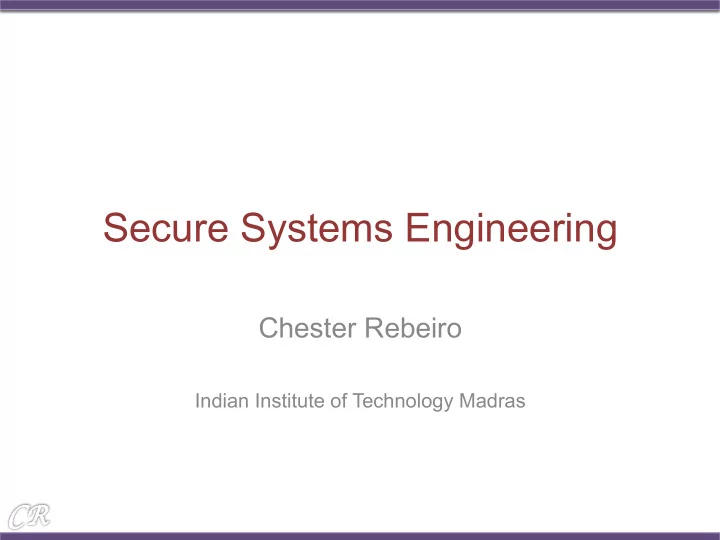

Secure Systems Engineering Chester Rebeiro Indian Institute of Technology Madras
Secure Systems • Computer systems can be considered a closed box. • Informa8on in the box is safe as long as nothing enters or leaves the box.
Systems S8ll Secure • Even with viruses, worms, and spyware around informa8on is s8ll safe as long as they do not enter the system 3
Vulnerability • A flaw that an aDacker can use to gain access into the system flaw 4
Flaws that would allow an aDacker access a system The aDacker just needs one flaw … any flaw!!! Design Flaws flaw The Human factor Bugs in the Program 5
You don’t need to be a granny to get fooled L Design Flaws flaw The human factor The Human factor Bugs in the Program 6
Program Flaws In applica8on soRware • SQL Injec8on – In system soRware • – Buffers overflows and overreads – Heap: double free, use aRer free Integer overflows – – Format string In peripherials • – USB drives; Printers In Hardware • – Hardware Trojans These are not really program flaws. Covert Channels • – Can exist in hardware or soRware 7
Secure Systems Engineering Approach 1: Design flawless systems eg. SeL4 (Not easy to develop these systems in a large scale) Sta8c analysis / Formal Proof Assistant eg. COQ
Secure Systems Engineering Approach 2: Make it difficult for the aDacker Develop systems that are secure in spite of flaws (detect aDacks)
Secure Systems Engineering Approach 3: Isolate systems : sandbox environments, virtual machines, trusted environments (trusted compu8ng) Takes care of the human factor as well
Course Structure Part 2 Programming flaws that have been Trusted Compu8ng exploited Design the System where the flaw no longer can exist Part 3 Make it difficult for ADack / the aDacker to Vulnerability / mount an aDack Malware detec8on Part 1
What to expect during this course • Deep study of systems: – SoRware • Assembly level • Compiler and OS level (Programming assignments in class and homework) – Hardware • Some computer organiza8on features • Analysis techniques • Sta8c, dynamic analysis / symbolic execu8on • Sta8s8cal analysis techniques and some ML (Programming assignments for homework) • Course Project & Reading assignment
Expected Learning Outcomes • Understand the internals of malware and other security threats • Evaluate security measure applied at the hardware, OS, and compiler • Understand trade offs between performance and security
Grading Quiz 1 : 15 marks Quiz 2 : 20 marks Endsem : 15 marks Assignments, project : 40 marks In class assignments / tutorials : 10 Dates as per academic calendar
Schedule G slot • Monday : 12:00-12:50 Wednesday : 16:50-18:30 Thursday : 10:00-10:50 Friday : 9:00-9:50 Move Monday 12:00-12:50 to Wednesday 17:40-18:30 ??? Laptop day! Need updated Ubuntu laptop (32 or 64 bit); You could also use an Ubuntu virtual machine
Websites and Communica8on • Reference Textbooks mostly research papers; will be provided as per topic • For slides and schedule hDp://www.cse.iitm.ac.in/~chester/courses/17o_sse/ • For communica8on : google groups invita8ons will be sent to your smail account (please mail me or the TAs if you don’t get an invite) • For assignment submissions IITM moodle
Recommend
More recommend